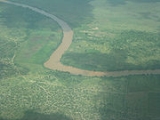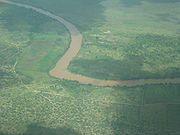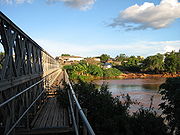
Jubba River
Encyclopedia
The Jubba River is a river
in southern Somalia
. It begins at the border with Ethiopia
, where the Dawa
and Ganale Dorya
rivers meet, and flows directly south to the Indian Ocean
, where it empties at the Goobweyn juncture.
 The earliest European to record his visit to the Jubba area is the Jesuit Jerónimo Lobo
The earliest European to record his visit to the Jubba area is the Jesuit Jerónimo Lobo
, who, in 1624, attempted to follow the course of the Jubba into Ethiopia
only to learn that he would need to pass through the lands of nine different peoples who "were continuously at war with one another and each one was scarcely secure in its own land than thus could not provide security for anyone who took a step outside of it", and returned to Portuguese India
to find another way there.
Over two centuries passed until Baron Karl Klaus von der Decken
ascended the lower reaches of the river on the small steamship Welf in 1863. He wrecked the steamship in the rapids above Baardheere, where the party was attacked by local Somalis, ending in the deaths of the Baron and three others in his party. The next European to explore the river was Commander Dundas of the British Navy, who sailed 400 miles of the river in 1891.
 The Jubba basin region is primarily savanna
The Jubba basin region is primarily savanna
, and is, ecologically speaking, the richest part of the country due to its fertile farmland. Native wild life include giraffe
s, cheetah
s, lion
s, leopard
s, hyena
s, buffalo
s, hippopotamus
, crocodile
s, oryx
, gazelle
s, camel
s, ostrich
es, jackal
s and wild donkey
s.
The Jubba River gives its name to the Somali administrative regions of Middle Juba and Lower Juba, as well as to the larger historical region of Jubaland
. Major cities which the Jubba River passes by include Buale, Doollow, Luuq
, Buurdhuubo
, Beledhawo
, Baardheere, Saakow
, Kamasuma, and Goobweyn near Kismaayo.
River
A river is a natural watercourse, usually freshwater, flowing towards an ocean, a lake, a sea, or another river. In a few cases, a river simply flows into the ground or dries up completely before reaching another body of water. Small rivers may also be called by several other names, including...
in southern Somalia
Somalia
Somalia , officially the Somali Republic and formerly known as the Somali Democratic Republic under Socialist rule, is a country located in the Horn of Africa. Since the outbreak of the Somali Civil War in 1991 there has been no central government control over most of the country's territory...
. It begins at the border with Ethiopia
Ethiopia
Ethiopia , officially known as the Federal Democratic Republic of Ethiopia, is a country located in the Horn of Africa. It is the second-most populous nation in Africa, with over 82 million inhabitants, and the tenth-largest by area, occupying 1,100,000 km2...
, where the Dawa
Dawa River
The Dawa River is a perennial river in southeastern Ethiopia. Rising in the mountains east of Aleta Wendo, the Dawa flows south and east to join with the Ganale Dorya at the border with Somalia to become the Jubba. The river forms part of the Ethiopia–Kenya border and part of the Ethiopia–Somalia...
and Ganale Dorya
Ganale Dorya River
The Ganale Dorya River is a perennial river in southeastern Ethiopia. Rising in the mountains east of Aleta Wendo, the Dawa flows south and east to join with the Dawa at the border with Somalia to become the Jubba. Tributaries include the Welmel, Weyib , Dumale, Doya, Hawas and the Hambala...
rivers meet, and flows directly south to the Indian Ocean
Indian Ocean
The Indian Ocean is the third largest of the world's oceanic divisions, covering approximately 20% of the water on the Earth's surface. It is bounded on the north by the Indian Subcontinent and Arabian Peninsula ; on the west by eastern Africa; on the east by Indochina, the Sunda Islands, and...
, where it empties at the Goobweyn juncture.
History

Jerónimo Lobo
Jerónimo Lobo was a Portuguese Jesuit missionary.He was born in Lisbon the third of at least five sons and six daughters to Francisco Lobo da Gama, the Governor of Cape Verde, and Dona Maria Brandão de Vasconcelos. He entered the Order of Jesus at the age of 14...
, who, in 1624, attempted to follow the course of the Jubba into Ethiopia
Ethiopia
Ethiopia , officially known as the Federal Democratic Republic of Ethiopia, is a country located in the Horn of Africa. It is the second-most populous nation in Africa, with over 82 million inhabitants, and the tenth-largest by area, occupying 1,100,000 km2...
only to learn that he would need to pass through the lands of nine different peoples who "were continuously at war with one another and each one was scarcely secure in its own land than thus could not provide security for anyone who took a step outside of it", and returned to Portuguese India
Portuguese India
The Portuguese Viceroyalty of India , later the Portuguese State of India , was the aggregate of Portugal's colonial holdings in India.The government started in 1505, six years after the discovery of a sea route to India by Vasco da Gama, with the nomination of the first Viceroy Francisco de...
to find another way there.
Over two centuries passed until Baron Karl Klaus von der Decken
Karl Klaus von der Decken
Baron Karl Klaus von der Decken was a German explorer of eastern Africa and the first European to attempt to climb Mount Kilimanjaro....
ascended the lower reaches of the river on the small steamship Welf in 1863. He wrecked the steamship in the rapids above Baardheere, where the party was attacked by local Somalis, ending in the deaths of the Baron and three others in his party. The next European to explore the river was Commander Dundas of the British Navy, who sailed 400 miles of the river in 1891.
Overview

Savanna
A savanna, or savannah, is a grassland ecosystem characterized by the trees being sufficiently small or widely spaced so that the canopy does not close. The open canopy allows sufficient light to reach the ground to support an unbroken herbaceous layer consisting primarily of C4 grasses.Some...
, and is, ecologically speaking, the richest part of the country due to its fertile farmland. Native wild life include giraffe
Giraffe
The giraffe is an African even-toed ungulate mammal, the tallest of all extant land-living animal species, and the largest ruminant...
s, cheetah
Cheetah
The cheetah is a large-sized feline inhabiting most of Africa and parts of the Middle East. The cheetah is the only extant member of the genus Acinonyx, most notable for modifications in the species' paws...
s, lion
Lion
The lion is one of the four big cats in the genus Panthera, and a member of the family Felidae. With some males exceeding 250 kg in weight, it is the second-largest living cat after the tiger...
s, leopard
Leopard
The leopard , Panthera pardus, is a member of the Felidae family and the smallest of the four "big cats" in the genus Panthera, the other three being the tiger, lion, and jaguar. The leopard was once distributed across eastern and southern Asia and Africa, from Siberia to South Africa, but its...
s, hyena
Hyena
Hyenas or Hyaenas are the animals of the family Hyaenidae of suborder feliforms of the Carnivora. It is the fourth smallest biological family in the Carnivora , and one of the smallest in the mammalia...
s, buffalo
African Buffalo
The African buffalo, affalo, nyati, Mbogo or Cape buffalo is a large African bovine. It is not closely related to the slightly larger wild Asian water buffalo, but its ancestry remains unclear...
s, hippopotamus
Hippopotamus
The hippopotamus , or hippo, from the ancient Greek for "river horse" , is a large, mostly herbivorous mammal in sub-Saharan Africa, and one of only two extant species in the family Hippopotamidae After the elephant and rhinoceros, the hippopotamus is the third largest land mammal and the heaviest...
, crocodile
Crocodile
A crocodile is any species belonging to the family Crocodylidae . The term can also be used more loosely to include all extant members of the order Crocodilia: i.e...
s, oryx
Oryx
Oryx is one of four large antelope species of the genus Oryx. Three of the species are native to arid parts of Africa, with a fourth native to the Arabian Peninsula. Their pelage is pale with contrasing dark markings in the face and on the legs, and their long horns are almost straight...
, gazelle
Gazelle
A gazelle is any of many antelope species in the genus Gazella, or formerly considered to belong to it. Six species are included in two genera, Eudorcas and Nanger, which were formerly considered subgenera...
s, camel
Camel
A camel is an even-toed ungulate within the genus Camelus, bearing distinctive fatty deposits known as humps on its back. There are two species of camels: the dromedary or Arabian camel has a single hump, and the bactrian has two humps. Dromedaries are native to the dry desert areas of West Asia,...
s, ostrich
Ostrich
The Ostrich is one or two species of large flightless birds native to Africa, the only living member of the genus Struthio. Some analyses indicate that the Somali Ostrich may be better considered a full species apart from the Common Ostrich, but most taxonomists consider it to be a...
es, jackal
Jackal
Although the word jackal has been historically used to refer to many small- to medium-sized species of the wolf genus of mammals, Canis, today it most properly and commonly refers to three species: the black-backed jackal and the side-striped jackal of sub-Saharan Africa, and the golden jackal of...
s and wild donkey
Somali Wild Ass
The Somali Wild Ass is a subspecies of the African wild ass. It was found in the Southern Red Sea region of Eritrea, the Afar Region of Ethiopia, and Somalia...
s.
The Jubba River gives its name to the Somali administrative regions of Middle Juba and Lower Juba, as well as to the larger historical region of Jubaland
Jubaland
Jubaland , also known as Azania or the Juba Valley and formerly as Trans-Juba , is an autonomous region in southern Somalia. Its eastern border lies 40–60 km east of the Jubba River, stretching from Gedo to the Indian Ocean, while its western side flanks the North Eastern Province in...
. Major cities which the Jubba River passes by include Buale, Doollow, Luuq
Luuq
Luuq or Lugh is a city in the southern Gedo province of Somalia. It is one of the oldest cities in the country, and is the seat of the Luuq District, one of the region's seven districts. The town is located in a bend of the Juba River, where the river flows down from north to south in a horseshoe...
, Buurdhuubo
Buurdhuubo
-Location:Burdhubo sits on the Jubba River in the Jubba Valley, between the cities of Bardera and Luuq. Garbahaarreey, the Gedo region's capital, is situated just away from Burdhubo.-Economy:...
, Beledhawo
Beledhawo
Beled Hawo is the second largest city in Gedo, the largest province in Somalia situated in the southwestern part of the country. The town is also the headquarters of Beled Hawo District, which, like most other districts in the region, is named after its principal town.-History:Beled Hawo was...
, Baardheere, Saakow
Saakow
Saakow is a town in the southern Jubbada Dhexe region in Somalia. It lies between Bu'ale, Dinsoor and Bardhere.-References:*...
, Kamasuma, and Goobweyn near Kismaayo.

